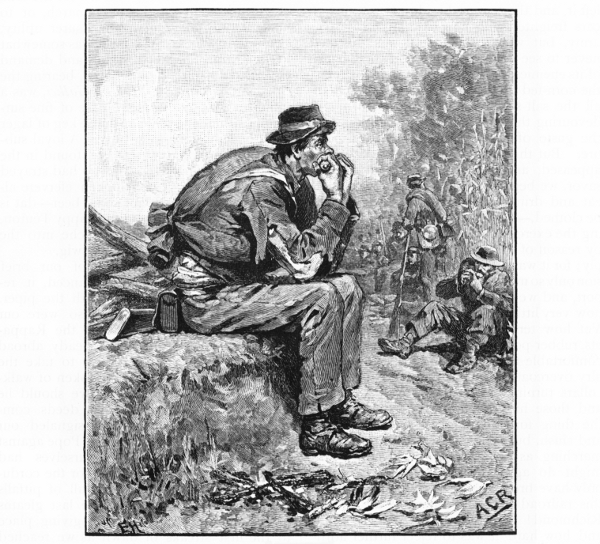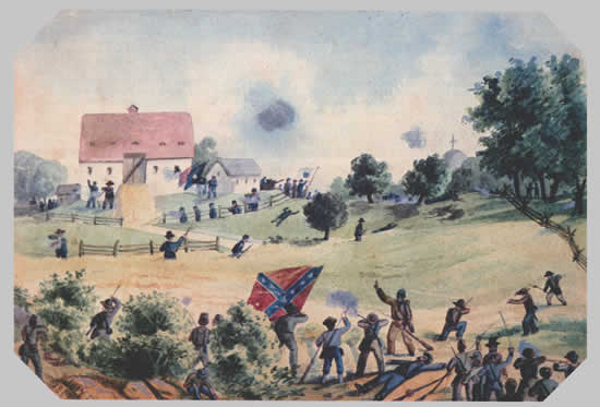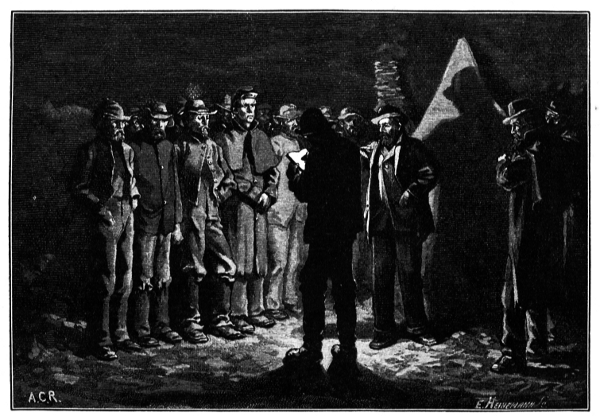The wearing of Federal uniforms by the 55th Virginia Infantry
The wearing of Federal clothing was, on occasions, common practice in the divisions of A. P. Hill and Henry Heth (to which the 55th belonged).
The first soldier of the 55th Va. to mention purloining and using an item of Federal uniform was Pvt. William Rouzie of Co. F. On September 8th 1862, he wrote to his sister, “we took manassas [on August 27th 1862] and got just what we wanted. I got pants [i.e. sky blue kersey trousers], a nice oil cloth and various other things.”1 At the same time, the artist Allen Redwood, serving in Co. C, 55th Va. broke into the baggage of the major of the 12th Penn. Cav. and requisitioned his spare underwear.2 Berry Benson of Gregg's brigade of Hill's division also took a pair of trousers. He recalled they were made of “weak stuff” and fell to pieces on him at Sharpsburg three weeks later.3 That these were not isolated instances can be inferred from this comment by Union general G. H. Gordon who fought the Confederates at both 2nd Manassas and Sharpsburg: “From piles of new clothing the Southerners arrayed themselves in the blue uniforms of the Federals.”4 Although Gordon implies the Confederates were taking coats as well as trousers at Manassas, it is perhaps significant that none of the Confederate accounts admit to doing so. Underwear and trousers wear out quickest and, initially, it was these the rebels were interested in. Redwood's four detailed pictures of the Manassas campaign show the 55th in deteriorating, but just about serviceable jackets. It is only when he comes to illustrate one of his comrades at the commencement of the Sharpsburg campaign that he starts to show jackets that are literally falling to pieces (Image 1).
On September 15th and 16th, one week into the Sharpsburg campaign, Hill's division was left to sort out the huge quantity of quartermaster stores captured at Harpers Ferry and it was now that the inevitable happened and the soldiers began seizing and wearing enemy clothing on a large scale, coats as well as trousers. We know this because, when Hill's division approached Sharpsburg by forced march on September 17th, Lee and his staff had difficulty identifying it as a Confederate formation and when its advance guard (Gregg's brigade) struck the enemy, the latter were thrown into confusion because the Confederates were wearing blue uniforms. Four days after the battle, Major J. M. Comly of the 23rd Ohio noted Gregg's men “had uniforms similar to ours, and which (I have since been informed by a prisoner) were taken at Harper's Ferry.”5
At least some of this enemy clothing remained in use for several months. Pvt. Samuel H. Darnell of Archer's brigade of Hill's division remembered escaping from the Federals after his unit was overrun at Fredericksburg on December 13th 1862, by the following means: “I had on a Yankey coat and another coat over it. I got the Yankey coat at Harpasfirry. I throwed my top coat open so they could see the under coat so them seeing I had on one of there coats they never ordered me to throw down my gun[.] they fullowed our men some distance about a quarter of a mile. I went on with them as far as they went my way…”6
During the night of December 13th, the hundreds of dead Union soldiers in front of the Confederate position at Fredericksburg were stripped of their clothing leaving most of them naked by morning. The rebels took this clothing in order to use it.7
As winter gave way to spring and as the Confederate Quartermaster Department's ability to supply uniforms improved, the probability is that the Army of Northern Virginia's soldiers became less and less inclined to indulge in the risky practice of wearing enemy coats. Certainly, Redwood's three illustrations of the 55th Va. at Gettysburg show only Confederate jackets in use. Strong hints remain, however, that the rebels continued to use Federal trousers in considerable numbers. In his charming watercolour painting of the 55th's attack on the Stone Barn at Gettysburg (Image 2) on July 1st 1863, Redwood portrays his comrades wearing a variety of grey clothing and one man is in butternut. Of the sixteen infantrymen in the picture whose trouser colour can be identified, five are wearing sky blue.
In her book A Southern Woman's Story, Phoebe Yates Pember, the formidable matron of Chimborazo No.2, Richmond recalled, “The men had their fashions, too, sometimes insisting upon having light blue pants drawn for them, and at other seasons preferring gray; but while the mania for either colour raged, they would be dissatisfied with the other.”8 What these “light blue pants” were made of and where they came from can only be conjectured. Possibly they were blue jeans manufactured by the government; perhaps they were captured Federal kerseys.
By the fall of 1864 the Confederate supply situation was again deteriorating.9 When the 55th Va.'s brigade moved forward to renew the attack at Pegram's Farm on September 30th, it passed large numbers of Federal prisoners coming the other way and many of these men were stripped of their clothing; so many in fact that when the Confederate brigade went into action it was momentarily mistaken by Federal officers for one of their own units.10 Subsequent inspection reports for October and November show the 55th still suffering clothing deficiencies.11
In January 1865, Allen Redwood, then serving in the 1st Maryland Cavalry Battalion, paid a visit to his old comrades in Co. C, 55th Va., then stationed at Chaffin's Bluff on the Richmond lines. He described their apparel thus: “A few old uniform jackets, once gray but now stained by dust and faded by sun and rain to a dingy yellow, still hold out against the vicissitudes of war, but the garb is uniform no longer: garments of civic cut and color prevail, interspersed with others, the dye of which proclaims them the spoil of the battle-field, stripped, under the prompting of hard necessity, from those who would never again need them…”12 He supplemented this description with a unique illustration of a soldier of Co. C wearing an enemy sack coat (Image 3):
At Sayler's Creek on April 6th 1865, Major Robert Stiles witnessed “a young fellow of one of my companies jam the muzzle of his musket against the back of the head of his most intimate friend, clad in a Yankee overcoat, and blow his brains out.”13
From the above quotes and illustrations we can draw the following conclusions: Firstly, jeancloth infantry trousers wore out more rapidly than jeancloth jackets or kepis and more rapidly than the Confederate government could replace them. From late August 1862 until the end of the war soldiers of the 55th habitually wore Federal sky blue kerseys whenever they could get hold of them. Secondly, from September 15th 1862 through to the spring of 1863 and again from September 30th 1864 until the closing days of the war some members of the 55th were even prepared to wear dark blue Federal sack coats. At the battles of Sharpsburg on September 17th 1862 and Pegram Farm on September 30th 1864, they and other members of the larger organizations to which they belonged were wearing so many of these blue uniforms that they were momentarily mistaken for the enemy.
Notes
1 Rouzie Family Papers, Swem Library, William and Mary College, Va.
2 Battles and Leaders, Vol. 2, page 533.
3 Berry Benson's Civil War Book, University of Georgia Press 1962, page 28.
4 From The Army of Virginia by General George H. Gordon, quoted on page 440 of the single volume edition of G. F. R. Henderson's Stonewall Jackson.
5 O.R. Series 1, Vol.19, Part 1, page 467. Also quoted in Battles and Leaders, Vol.2, page 655.
6 Veterans Questionnaire, Tennessee State Library & Archives.
7 The 48th in the War: being a Narrative of the Campaigns of the 48th Regiment, Infantry, Pennsylvania Veteran Volunteers…, by O. C. Bosbyshell, page 100; referred to in note 10 of section 1 of chapter 2 of Bruce Catton's Glory Road.
8 A Southern Woman's Story, by Phoebe Yates Pember, McCowat-Mercer Press 1959, page 105.
9 Inspection Report on Fry's brigade, dated August 15th, 1864. U.S. National Archives (M935)
10 Richmond Redeemed, by Richard Sommers, Doubleday & Co. 1981, pages 301 - 302.
11 Inspection Reports on Archer's brigade, dated September 30th, October 30th and November 29th 1864. U.S. National Archives (M935)
12 “The fortunes and misfortunes of Co. ‘ C’ ”, by Allen Redwood. Scribner's Monthly, Vol. XVII (1878/79, page 535.)
13 Four Years Under Marse Robert, by Major Robert Stiles, Morningside 1977, page 333.


